Wild hogs have been an ever-expanding problem for gamekeepers, hunters, farmers, and property managers for years. It is a battle that never ends. As one hog or sounder is removed from the landscape another is bound to arrive from a nearby property that is not trying to eliminate the invasive species, or at least manage the population. What are some options available for gamekeepers, hunters, farmers, and property managers that are learning to live with wild hogs?
Common Options for Controlling Wild Hogs
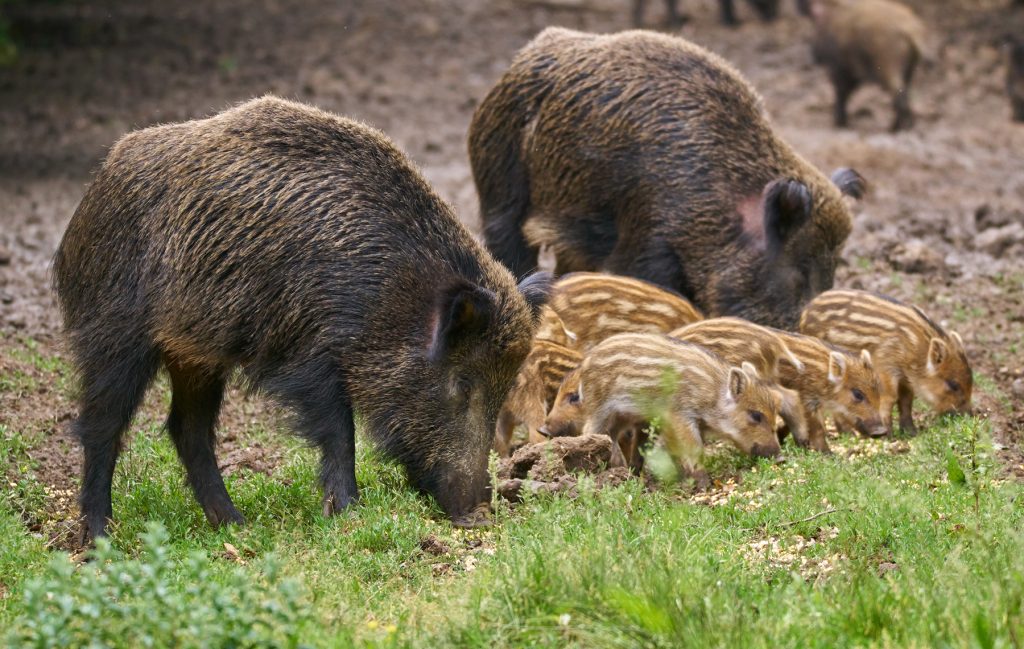
Night Hunting Wild Hogs
Most people are aware of the practice of hunting wild hogs at night when they can be found up and moving. Night hunting can be done in several ways. One of the most common that people often start with is using a spotlight (where legal). Some people will Learuse night vision, or increasing in popularity are thermal scopes. These scopes have become a lot clearer recently, and the prices have come down. Hogs are also taken as targets of opportunity while hunting other species such as deer or turkeys. Hunting alone normally only puts a small dent on the population, but it does put meat in the freezer. Some people say they will never eat a wild hog, but if prepared correctly it tastes as good as, or even better than a domestic hog.
Trapping Wild Hogs
Some have resorted to trapping hogs. I have seen people use small traps with a trapdoor with very limited success. If you don’t catch the entire sounder, you’ve just educated the hogs that didn’t get caught to avoid traps forever. Others have used fencing that hogs can push in to get to the feed, but then they don’t have the ability to the open the door to get out. The drop traps have also become very popular, and from my experience tend to have much higher catch rates than others. Most drop traps are run using remotes, or smart phone aps. They are also very costly, but the cost is often justified by the convenience and efficiency of this style trap along with the savings in crop damage or damage to food plots. However, hogs are intelligent animals that learn to avoid traps, especially those that they must pass through or come in contact with to be caught.
Other Options
Despite using these methods on numerous properties throughout the country, it seems the best most can do is to end in a stalemate. Therefore, we’re left with trying to keep their numbers in check as best we can and struggling to limit the damage they cause. The sad truth is that once the hunting dries up and the hogs have become trap-conscious, the wild hogs tend to out produce human’s best efforts. So then what? What options are available if the total removal of wild hogs is not a likely option? I have several friends who have begun to ask. What can we do to live with this invasive species that seems to be here for good… at least at this point?
A Common Scenario
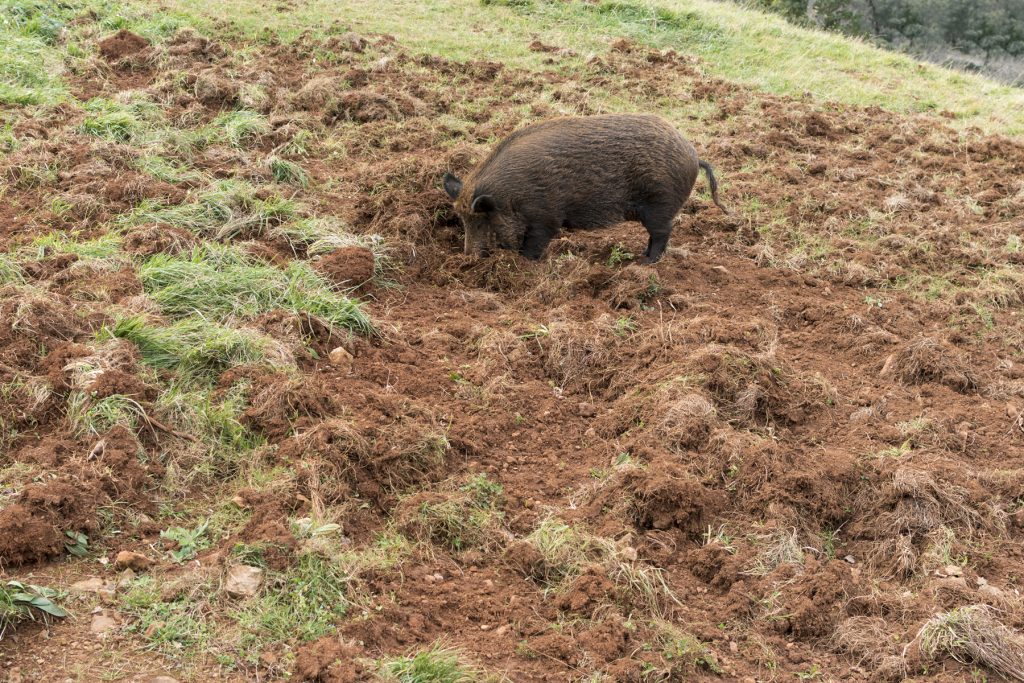
“Necessity is the mother of invention,” as the saying goes. Recently a farm I have hunted on would only have a lone boar hog during in the wintertime, while they are living a solitary life prior to sows coming into heat. Then in the summer of 2021, the first sounder was observed. I was out one evening photographing deer coming into a sorghum field with a good friend when I could hear “pig squealing” coming from a swamp adjacent to the field. I then knew why we had not been seeing very many deer that evening. As light began to fade to the point so that photographing deer would be futile, the hogs began to pour into the field. Through our binoculars, we counted 20-plus hogs in the sounder with several pregnant sows. We let the landowner know that he had a major problem and that he needed to act fast. This was the first time the sounder had ventured into the field since the farmer said he had been in the field that day, and there was no rooting present.
Trapping
On that particular farm, the farmer elected to try trapping, and did not want anyone to hunt the hogs. He had hoped to get the entire sounder on one night. On the first attempt, he used a guillotine trapdoor style trap he had heard about, using thick gauge hog wire and T-posts ― so that the hogs could push open the gate, but could not get out since the gate was longer that the opening. This style trap would not allow the hogs to get out since they would be pushing the gate against the wire of the trap and several T posts placed where it would make contact. The first night they caught only eight out of the sounder – one that was able to jump out as they arrived at the trap that morning. The population grew as several pregnant sows were not trapped that night.
The second attempt only yielded six hogs because the hogs had become educated about the trap with several trail camera pictures showing the older, larger hogs staying on the edge of the trap and never pushing inside to the larger pile of corn. He then switched to a drop style trap, but with educated hogs, some still escaped this effective style of trap to continue to rebuild and increase the local wild hog population.
Hunting
On a neighboring property, as the wild hogs started to arrive on his land in ever increasing numbers, the landowner elected to hunt with lights, and as targets of opportunity while deer hunting. From August 2021, through January 2022, he, along with some friends, killed ten, but that did very little to the population. The only real change that it made on his property was that the hogs moved their feeding later into the night.
Doing Nothing
Neighboring landowners’ feared hunting and trapping would affect their deer hunting. Nothing could be said to convince them to help control the wild hog population, even with hogs destroying their food plots. The hogs then began to take up permanent residence in the unpressured areas allowing the population to explode. Wild hogs still continued to venture to farms where trapping was conducted, and hunting land where they were shot when seen.
Does this sound familiar? The necessity to protect food plots and crops brought minds together. A solution was needed that acknowledged the fact that it was very unlikely the wild hogs would be eradicated from the habitat, yet still protect food plots and crops, while trying to keep the wild hog population in check as much as possible.
I have read, and heard, several times that we cannot trap or shoot our way out of the problem. How do we learn to manage and protect our resources with hogs now as much a part of many ecosystems as doves, ducks or deer. The reality becomes – how do we live in this new reality as gamekeepers, hunters, farmers, and property managers.
The Fence Option
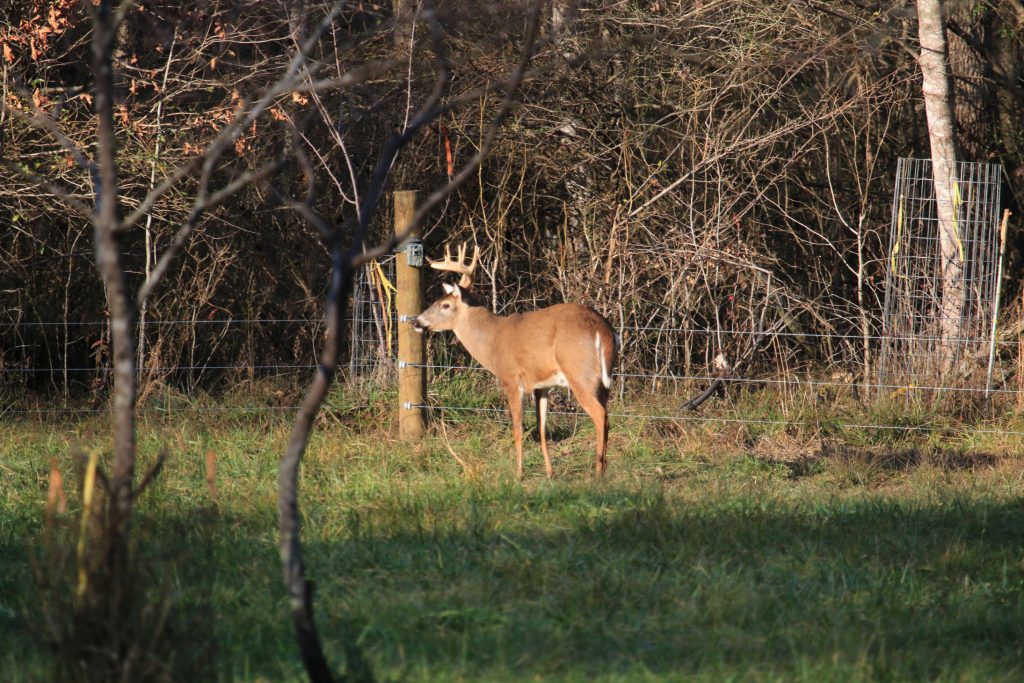
One of the solutions that was implemented was to use electric fence. This design was not to keep domestic livestock in, but specifically to keep the invasive wild hogs out. Friends that own Southland Power Fence Feed and Equipment Company had been asked by a farmer in South Georgia to help keep hogs out of his fields. The use of an electric fence was the best and cheapest solution that they could come up with ― versus other fencing options. When this electrical fence concept was proposed, it had several advantages in addition to lower cost.
More Flexibility
Electrical fences allow more flexibility for gamekeepers. The fence can more easily follow the edge of the field or food plot. Electric fences can also be used to weave in between trees or other obstacles as well. The fence can also be moved easier than other fencing options. Solar chargers and modern batteries make electric fences a more practical option today especially for protecting remote food plots that do not have electrical lines nearby.
It’s also something that can be done by yourself. My friend, who is a farmer, did it on his own because he has a tractor and auger to complete the project. Another acquaintance of mine hired our friends to put up the fence since he doesn’t have any of the equipment to complete the project, nor the experience in working with electrical fences. One of the biggest advantages in my mind being a gamekeeper is that the electric fence does not significantly impact or interfere with native wildlife. Deer, rabbits, raccoons, songbirds, turkeys and other wildlife are still seen in the areas protected with the electric fence.
Hog Fence Set-Up
What does it take to create this barrier to wild hogs? The installers at Southland utilize three strands of electrical fence wire. The spacing of the lowest wire is nine inches off the ground so that it will contact piglets, the middle strand is eighteen inches off the ground, and the top strand is thirty inches from the ground.
You will also need an energizer. They said that one for a food plot would cost approximately $300. To cover larger fields they said a larger solar charger would be needed and that would cost between $1,000 and $1,200, or a person could use multiple smaller chargers. If a power source were available, then you would only need to have a plug close by. However, most applications require solar energizers.
The most important thing emphasized in our conversation was having adequate grounding. They said a person must use two galvanized grounding rods ten-feet apart for food plots from a quarter-acre on up to around five acres. As the area covered increases, more rods must be added at the ten foot spread. It was stressed that a rusted piece of rebar will not work for this application.
At current prices, it would run around eighty-five cents per foot for the wires. The post used and spacing would be up to the individual which would greatly influence the cost. If you have a tractor with an auger install it yourself, it’s a great saving on cost. For my friend without a tractor who did not want to do it by hand, had them install the posts, fence, grounds, and solar energizer, and it cost him approximately $900 to cover a food plot that is a third of an acre.
 Fence Maintenance
Fence Maintenance
Once installed, the maintenance is very minimal. Spraying around the fence is important ― wet grass or weeds can draw the electricity or knock out the power. It is also important to keep limbs and bushes pruned back. Make certain the solar panels have access to adequate sunlight. Over time the battery and charger might need to be replaced, but that should be years down the road. If a tree or large limbs fall on the wires it can quickly be repaired by simply removing the tree or limbs, standing the wires back up and possibly replacing one or two posts. If you put up other types of fencing you would have to replace an entire section of fencing at a much higher cost.
The Effectiveness of Fencing for Wild Hogs
The proof of the effectiveness of using an electric fence to keep wild hogs out is in the sign (rooting, or the lack of rooting). Hogs have not stepped foot in my friend’s food plot since the fence went up almost twelve months ago. They have been captured on trail cameras in the hardwoods by the food plot ― and the neighbor’s food plot that can be seen from my friend’s food plot (eighty yards away) looks like a tractor has plowed it up from all of the damage they cause. Other neighboring food plots and fields have been rooted up to the point that they had to be replanted.
The hogs have only appeared to have approached the fences once or twice. Hogs are very intelligent animals. In this area they have been using this method for over seven years with great success. The wild hogs have learned to avoid the electric fence much like they learn to avoid traps.
The owners at Southland said in one of the fields that they have worked on in South Georgia they had a group of hogs that had been fenced inside a six hundred acre corn field. The farmer hunted the hogs as much as they could. The hogs would run circles in the large field when pressured, and had created a wallow under the center pivot that allowed them to get water. As the farmer was combining, the hogs would hold tight to cover, and would never run near the electric fence when forced to flee.
Three words that gamekeepers like to hear is that the method is tested, effective, and affordable. The system has prevented crop and food plot damage in the enclosed areas since the fences have been put up. The fence will pay for itself in crops saved, replanting costs, and tractor work, much less the time involved. I have found deer tend to avoid hogs, so the fence has made them feel more at ease, and will result in increased sightings. If we cannot eradicate wild hogs, we must learn to live with them, and electric fences could be a game changer for gamekeepers dealing with wild hogs.

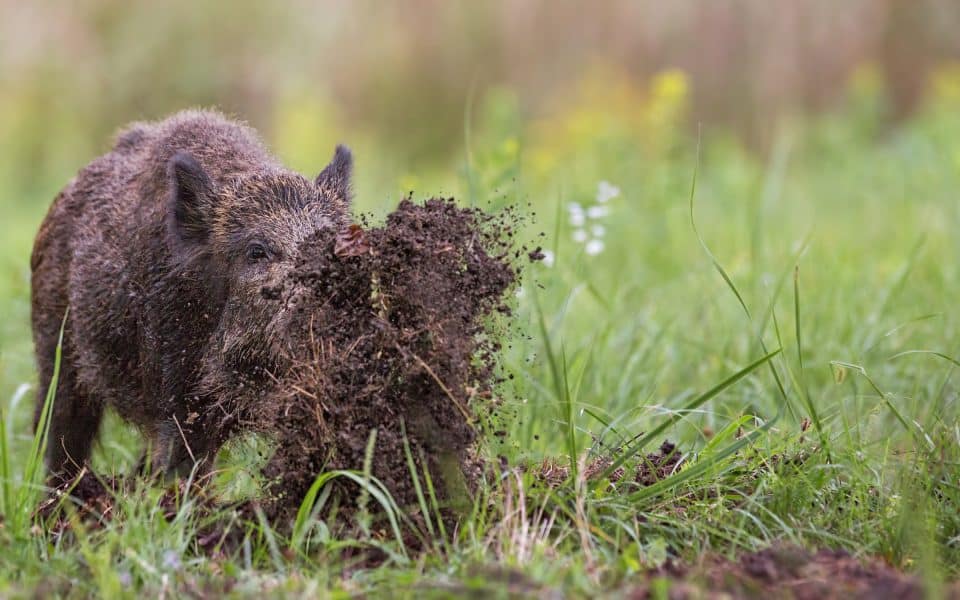

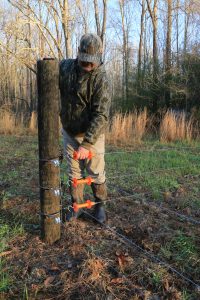 Fence Maintenance
Fence Maintenance




